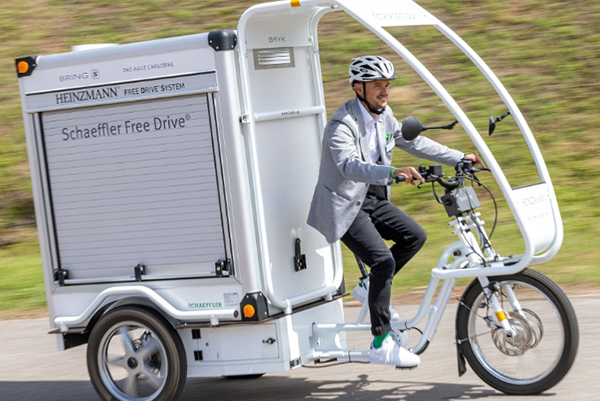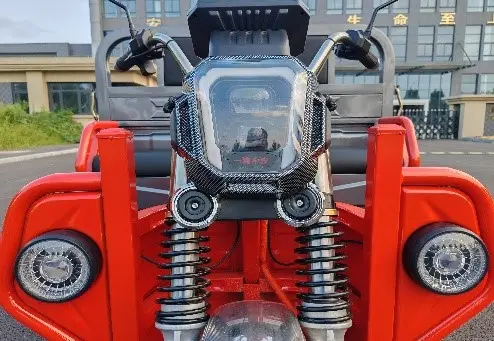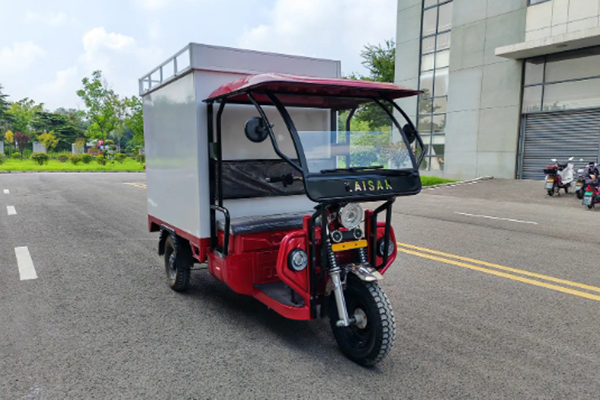In today’s fast-paced world, efficient and eco-friendly delivery solutions are no longer a luxury—they’re a necessity. This article dives deep into the world of electric cargo bikes, exploring how these versatile vehicles are transforming businesses across various sectors. From streamlining last-mile delivery to offering sustainable transportation options, discover why investing in electric cargo bikes is a smart move for your company’s future and how they offer a compelling alternative to traditional vehicles. Read on to understand the benefits, features, and considerations when choosing the right electric cargo bike for your specific needs.

1. What Exactly is an Electric Cargo Bike and Why Should You Care?
An electric cargo bike, often also referred to as an electric cargo tricycle or cargo trike, is essentially a bicycle that’s been specifically designed to carry cargo. But it’s not just any bicycle; it’s equipped with an electric motor to provide pedal assistance, making it easier to carry heavy loads and navigate hills, especially in busy urban environments. Think of it as a blend between a traditional bike and a small delivery vehicle. These three-wheeled vehicles are becoming increasingly popular because they offer a sustainable, efficient, and often faster way to move goods and even people within cities.
Why should you, as a business owner or fleet manager, care about electric cargo bikes? The answer is multifaceted. Firstly, they represent a significant step towards greener operations, reducing your carbon footprint and aligning with growing environmental consciousness among consumers and regulators. Secondly, they can drastically cut down on operational costs compared to vans or trucks. Less fuel, lower maintenance, and often exemptions from congestion charges in many cities translate to substantial savings. Finally, in congested urban areas, electric cargo bikes can often navigate traffic more quickly, offering faster and more reliable delivery times, enhancing customer satisfaction. For businesses focused on last-mile delivery, logistics, or even passenger transport in specific niches like tourism, electric cargo bikes are not just a trend, but a practical and increasingly vital solution.
2. Electric Cargo Bike vs. Traditional Van: Which is the Better Choice for Urban Logistics?
The debate between electric cargo bikes and traditional vans for urban logistics is becoming more pertinent as cities grow denser and environmental concerns escalate. While vans have long been the workhorse of urban delivery, electric cargo bikes present a compelling alternative, especially for certain types of operations. Let’s break down the key differences and advantages of each.
Vans, powered by combustion engines, offer significant cargo capacity and range, making them suitable for long distances and very large deliveries. However, they are also major contributors to urban congestion and air pollution. Operating costs, including fuel, insurance, and maintenance, can be substantial and are subject to fluctuating fuel prices. Maneuvering large vans in crowded city centers and finding parking can be time-consuming and inefficient, impacting delivery schedules.
On the other hand, electric cargo bikes excel in maneuverability and accessibility in urban environments. Their smaller size allows them to navigate through traffic jams, utilize bike lanes, and often park closer to delivery points. Operating costs are significantly lower due to minimal energy consumption (electricity is generally cheaper than fuel) and reduced maintenance needs. Electric cargo bikes are zero-emission vehicles, contributing to cleaner air and a healthier urban environment, which can enhance a company’s public image and appeal to environmentally conscious customers. While their payload capacity is less than a van, for many urban delivery tasks, especially last-mile deliveries of smaller packages, food, or documents, an electric cargo bike is perfectly adequate and often more efficient. The choice ultimately depends on the specific needs of your business, delivery distances, and the type of cargo being transported. For short-distance, high-frequency deliveries in congested cities, the electric cargo bike is increasingly proving to be the superior choice.
3. What are the Key Advantages of Using an Electric Cargo Trike for Your Business Operations?
Choosing an electric cargo trike over other types of cargo bikes, like two-wheelers, brings a unique set of advantages that can significantly benefit various business operations. Stability and safety and ease are paramount, especially when carrying things. The three-wheeled design of a cargo trike offers inherent stability, making it much easier to handle heavy loads and maintain balance issues, particularly for riders who may not be experienced cyclists or when navigating uneven surfaces or rough terrain. This stability translates to safer operation, reducing the risk of accidents and damage to goods, and boosting rider confidence.
Another key advantage is increased cargo capacity and a more versatile cargo box. Electric cargo trikes typically offer larger and more robust cargo box options compared to two-wheelers. This extra storage space is ideal for businesses that need to transport larger volumes of goods, bulkier items, or specialized equipment. The design often allows for customized cargo box configurations to suit specific needs, such as refrigerated units for food delivery or secure compartments for valuable goods. Furthermore, the ease of loading and unloading cargo is often improved with trikes due to their stable platform and accessible cargo box design. For businesses prioritizing stability, safety, and substantial cargo capacity, especially in urban delivery and logistics scenarios, the electric cargo trike presents a compelling and efficient solution. Think of it as a mini-truck, but with the agility and eco-friendliness of a bike.
4. Passenger vs. Cargo Electric Tricycle: Understanding the Different Types and Applications
The world of electric tricycles extends beyond just cargo transport; passenger versions are also gaining traction, each serving distinct purposes. Understanding the difference between passenger electric tricycle and electric cargo tricycle is crucial for selecting the right vehicle for your business needs. Electric cargo tricycles, as we’ve discussed, are designed primarily for transporting goods. Their key features include a robust frame, a large cargo box or platform, and powerful motors to handle heavy payloads. They are ideal for last-mile delivery, logistics, and transporting equipment or supplies for various businesses.
On the other hand, passenger electric tricycles are designed to carry passengers. They often feature comfortable seating, weather protection, and safety features tailored for human transport. Think of rickshaw type models, or more enclosed designs that offer protection from the elements. These are often used in tourism, ride-sharing services in specific areas, or for providing accessible transportation for elderly or disabled individuals. While some cargo trikes might have limited passenger capacity for a rider or two, their primary function remains cargo. Conversely, passenger trikes prioritize passenger comfort and safety over cargo volume. Some models can be versatile, offering modular designs that can be adapted for either cargo or passenger transport, but generally, the core design and features are optimized for one primary purpose. Choosing between a passenger or cargo electric tricycle depends entirely on whether your business needs to move goods or people.
5. What Load Capacity and Cargo Box Size Do You Need for Your Electric Cargo Carrier?
Determining the appropriate load capacity and cargo box size for your electric cargo carrier is a critical step in selecting the right model. Overestimating can lead to unnecessary bulk and inefficiency, while underestimating can result in operational limitations and potential safety hazards. Consider the typical weight and volume of the cargo you’ll be transporting regularly. For businesses delivering small packages or documents, a smaller cargo box and lower load capacity might suffice. However, for businesses transporting groceries, larger parcels, or equipment, a larger cargo box and higher payload capacity are essential.
Load capacity is usually specified in kilograms or pounds and refers to the maximum weight the electric cargo trike is designed to carry cargo safely. Cargo box size is typically measured in cubic feet or liters, indicating the volume of space available for goods. Think about the dimensions of your typical cargo items as well. A large, but light item might require a large cargo box but not necessarily a high load capacity. Conversely, dense, heavy items will demand a high load capacity even if they are compact. It’s also wise to consider potential future needs and choose a model with slightly more capacity than your current requirements to accommodate business growth or occasional larger loads. Always prioritize safety and adhere to the manufacturer’s recommended load limits to ensure safe operation and prolong the lifespan of your electric cargo carrier. Remember, exceeding the specified payload can strain the motor, brakes, and frame, leading to premature wear and tear and compromising safety.

6. Battery Range, Motor Power, and Charging: Essential Specs for Electric Cargo Bikes Explained
Understanding the battery range, motor power, and charging aspects of electric cargo bikes is crucial for ensuring they meet your operational demands. These specifications directly impact the performance, efficiency, and practicality of the vehicle in daily use. Battery range refers to the distance an electric cargo bike can travel on a single charge. This is influenced by factors like battery capacity (measured in watt-hours or amp-hours), payload, terrain, and riding style. For urban delivery, a range of 50 miles or more might be necessary to cover daily routes without needing to recharge during work hours. Consider your typical delivery distances and daily mileage when assessing battery range.
Motor power, measured in watts, determines the electric cargo bike’s ability to handle hills, headwinds, and heavy payloads. A more powerful motor will provide better acceleration and hill-climbing ability, especially when loaded with cargo. For cargo trikes, a hub motor or mid-drive motor system is common, with power outputs ranging from 250W to 750W or even higher for heavy-duty models. Charging time is another critical factor. Electric cargo bike batteries can typically be charged using standard household outlets, but charging times can vary from a few hours to overnight depending on battery capacity and charger type. Faster charging options might be available for some models to minimize downtime. Battery lifespan is also important; high-quality batteries, like those using Samsung or similar cells, are designed for hundreds or even thousands of charge cycles, ensuring long-term reliability and performance. When evaluating electric cargo bikes, carefully examine the battery and motor specs to ensure they align with your daily operational needs and desired performance levels.
7. Durability and Reliability: What Makes a High-Quality Electric Cargo Trike?
Durability and reliability are paramount when investing in an electric cargo trike for business use. These vehicles are expected to withstand daily wear and tear, heavy loads, and varying weather conditions. Several factors contribute to the durability and reliability of an electric cargo trike. The frame material and construction are fundamental. High-quality bike frames made from steel or aluminum alloy provide a robust and long-lasting foundation. Look for bike frames with reinforced welds and sturdy construction designed to handle heavy payloads and rough urban roads.
Components also play a crucial role. High-quality motors from reputable brands, like Bosch cargo line, are designed for consistent performance and longevity. Similarly, reliable battery systems using quality cells, like Samsung, ensure consistent range and lifespan. Durable braking systems, robust wheels and tires (especially fat tires for better shock absorption and stability), and quality drivetrain components are essential for reliable operation. Consider the reputation of the manufacturer and the quality of components used. A well-built electric cargo trike will not only last longer but also require less frequent maintenance and repairs, minimizing downtime and operational costs. Investing in quality upfront pays off in the long run through increased reliability, reduced maintenance, and a longer service life for your electric cargo trike fleet.
8. Compliance and Safety Standards: Ensuring Your Electric Cargo Bike Meets Regulations
Compliance with safety standards and local regulations is non-negotiable when deploying electric cargo bikes, especially for commercial operations. Regulations vary by region and country, covering aspects like vehicle classification, motor power limits, speed restrictions, lighting, braking, and safety equipment requirements. Ensure that the electric cargo bike models you are considering are designed to meet the relevant regulations in your operating area. In the USA, for example, electric bikes are typically classified based on motor power and speed assistance levels, with specific regulations varying by state and locality. European standards, such as EN 15194, define requirements for electric pedal-assisted bicycles (EPACs), including safety and performance criteria.
Compliance extends beyond just the vehicle itself. Riders may need to adhere to traffic laws and licensing requirements, depending on local classifications of electric cargo bikes. Safety features are also crucial. Ensure electric cargo bikes are equipped with adequate lighting (headlights, taillights, and turn signals), reliable braking systems (hydraulic disc brakes are often preferred for cargo trikes due to their stopping power), and reflectors for visibility. Consider models with features like integrated locks, robust parking brakes, and stable three-wheeled designs to enhance safety and security. Always prioritize models from reputable manufacturers who prioritize safety and compliance, and verify that the electric cargo bikes you choose meet all applicable local and national regulations to avoid legal issues and ensure rider safety.
9. Customization and Features: Tailoring Your Electric Cargo Bike to Specific Business Needs
One of the significant advantages of electric cargo bikes is their potential for customization and feature additions to meet specific business needs. Beyond the basic electric cargo trike, manufacturers often offer a range of options and accessories to tailor the vehicle to particular applications. Cargo box configurations can be customized – you can opt for a standard open box, a lockable container, a refrigerated unit for temperature-sensitive goods, or even a platform for oversized items. Some models offer modular cargo box systems that can be easily swapped or reconfigured.
Battery options can also be tailored. You might choose between different battery capacities to match your required range, or select fast-charging batteries to minimize downtime. Features like GPS tracking, alarm systems, and remote diagnostics can be integrated for fleet management and security. For rider comfort and ergonomics, adjustable handlebar and seat post options are often available. Consider features like integrated lighting systems, mudguards, and weather protection (such as canopies or windshields) for all-weather operation. Some manufacturers even offer branding and color customization to align the electric cargo bikes with your company’s corporate identity. When selecting an electric cargo bike supplier, inquire about the available customization options and features to ensure you can tailor the vehicles to perfectly fit your specific operational requirements and enhance efficiency and functionality.

10. How to Choose the Right Electric Cargo Bike Supplier: Key Considerations for B2B Buyers
Selecting the right electric cargo bike supplier is a critical decision for B2B buyers. It’s not just about the initial purchase price; it’s about establishing a long-term partnership that ensures reliable supply, quality products, and ongoing support. As a factory specializing in electric tricycles in China, we understand the key considerations from a supplier’s perspective. Firstly, assess the supplier’s reputation and experience. Look for manufacturers with a proven track record in producing high-quality electric cargo bikes and serving international markets. Check for certifications, quality control processes, and customer testimonials.
Product quality and range are paramount. Ensure the supplier offers electric cargo bikes that meet your required specifications in terms of load capacity, battery range, motor power, and durability. A diverse product range allows you to choose models that precisely fit different operational needs. Competitive pricing is important, but prioritize value over just the lowest price. Consider the total cost of ownership, including maintenance, spare parts availability, and warranty. Speaking of which, a comprehensive warranty and after-sales service are essential. Ensure the supplier provides adequate warranty coverage for the electric cargo bikes and offers reliable after-sales support, including spare parts availability and technical assistance. Communication and responsiveness are key. Choose a supplier who communicates effectively, responds promptly to inquiries, and is willing to understand and address your specific needs. Finally, consider logistics and shipping. Understand the supplier’s shipping capabilities, lead times, and logistics costs, especially if you are importing from overseas. Visiting exhibitions like trade shows is an excellent way to meet potential suppliers, assess product quality firsthand, and establish direct communication. And of course, Google search can be a valuable tool for initial supplier discovery and research.
11. Real-World Applications: How Businesses are Successfully Using Electric Cargo Bikes Today
Electric cargo bikes are no longer a niche concept; they are being successfully deployed across a wide range of industries and business applications. Last-mile delivery is perhaps the most prominent application. Logistics companies and delivery services are using electric cargo bikes to efficiently and sustainably deliver packages, groceries, and food in urban areas. Their maneuverability and lower operating costs make them ideal for navigating congested city streets and making frequent stops. Small business owners are also leveraging electric cargo bikes for various purposes. Caterers use them to transport food and equipment, tradespeople use them to carry tools and supplies to job sites, and mobile coffee vendors use them as compact and eco-friendly mobile businesses.
In tourism, passenger electric tricycles are used for guided tours and shuttle services, offering a unique and environmentally friendly way for tourists to explore cities. Some ride-sharing companies are incorporating electric tricycles into their fleets in specific urban areas, providing an alternative to cars for short-distance trips. Government agencies are also exploring the use of electric cargo bikes for tasks like postal delivery, park maintenance, and urban services. Examples abound globally – from courier companies in Europe using Urban Arrow and Nihola cargo bikes for inner-city deliveries, to businesses in the USA utilizing Tern GSD longtails and cargo trikes for local transport. The versatility and adaptability of electric cargo bikes are driving innovation and efficiency across diverse sectors, proving their practical value in modern urban environments.
12. Looking Ahead: The Future of Electric Cargo Bikes in Urban Transportation
The future of electric cargo bikes in urban transportation is bright and promising. As cities become increasingly congested and focus on sustainability, electric cargo bikes are poised to play an even more significant role in urban logistics and transportation ecosystems. Technological advancements will continue to improve battery technology, motor efficiency, and vehicle design, leading to longer ranges, higher payload capacities, and enhanced performance. We can expect to see further integration of smart technologies, such as GPS tracking, IoT sensors, and data analytics, to optimize fleet management, delivery routes, and operational efficiency.
Policy support and infrastructure development will be crucial drivers of adoption. Cities are increasingly implementing policies that favor zero-emission vehicles, such as congestion charging exemptions, dedicated bike lanes, and parking incentives for electric cargo bikes. Investment in charging infrastructure and maintenance facilities will further support widespread adoption. Consumer awareness and acceptance are also growing. As more businesses and individuals experience the benefits of electric cargo bikes, their popularity and demand will continue to rise. The trend towards micro-mobility and sustainable urban logistics is firmly established, and electric cargo bikes, especially electric cargo tricycles, are at the forefront of this revolution, offering a practical, efficient, and eco-friendly solution for the future of urban transportation.
Key Takeaways:
- Electric cargo bikes are transforming urban logistics and offering a sustainable alternative to vans.
- Electric cargo trikes provide superior stability and cargo capacity compared to two-wheelers.
- Understanding battery range, motor power, and cargo box size is crucial for choosing the right model.
- Durability, reliability, and compliance with safety standards are essential for commercial use.
- Customization options allow tailoring electric cargo bikes to specific business needs.
- Choosing a reputable supplier is vital for long-term success.
- Electric cargo bikes are being successfully applied across various industries, demonstrating their versatility.
- The future of electric cargo bikes in urban transportation is bright, driven by technology, policy, and growing demand.
Post time: 02-10-2025




